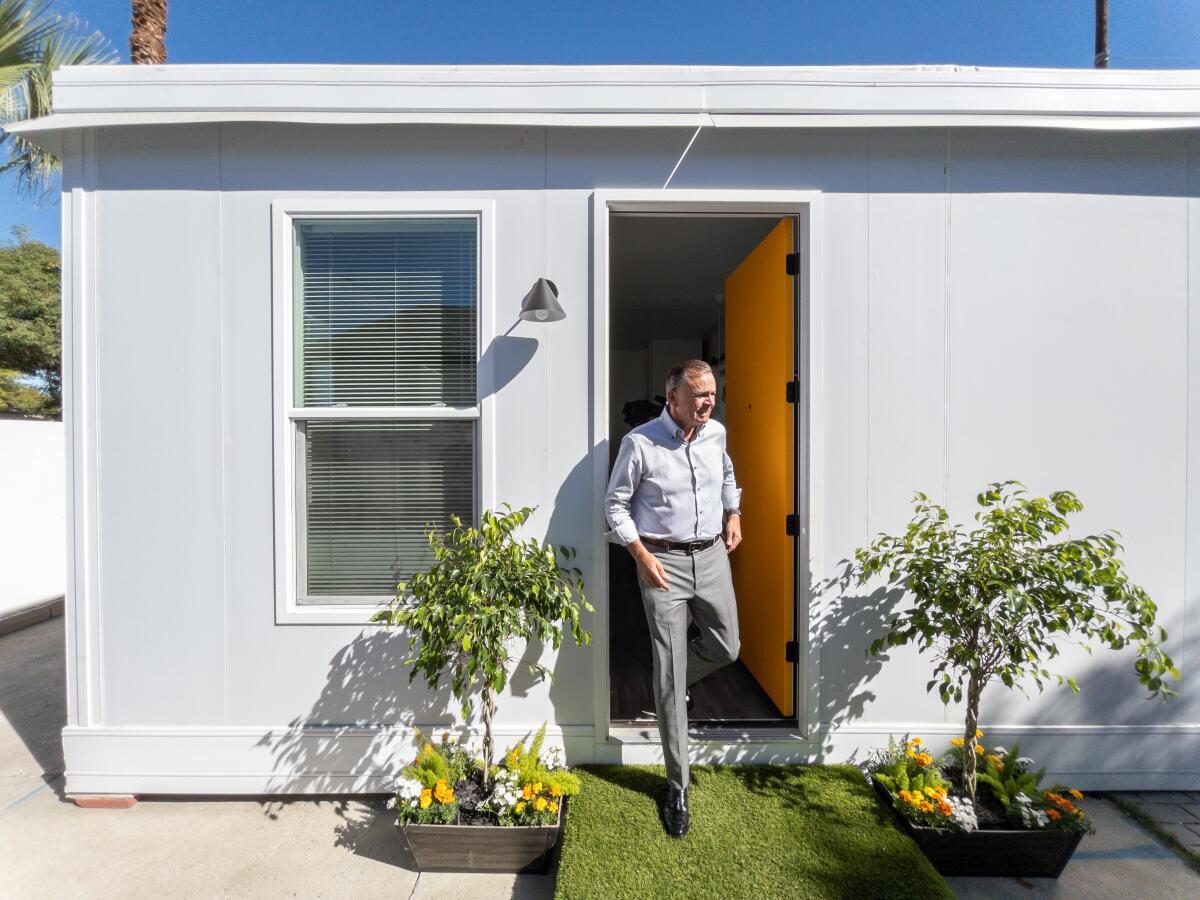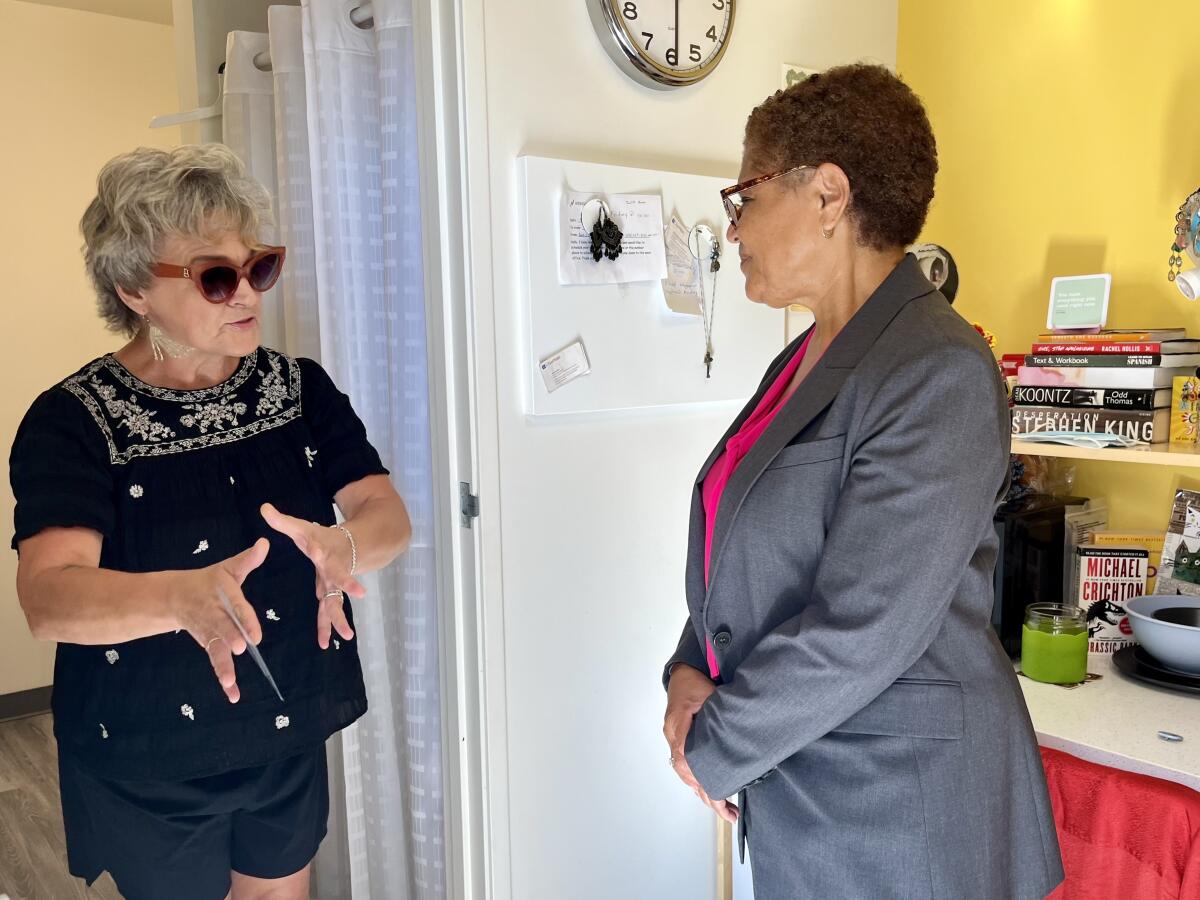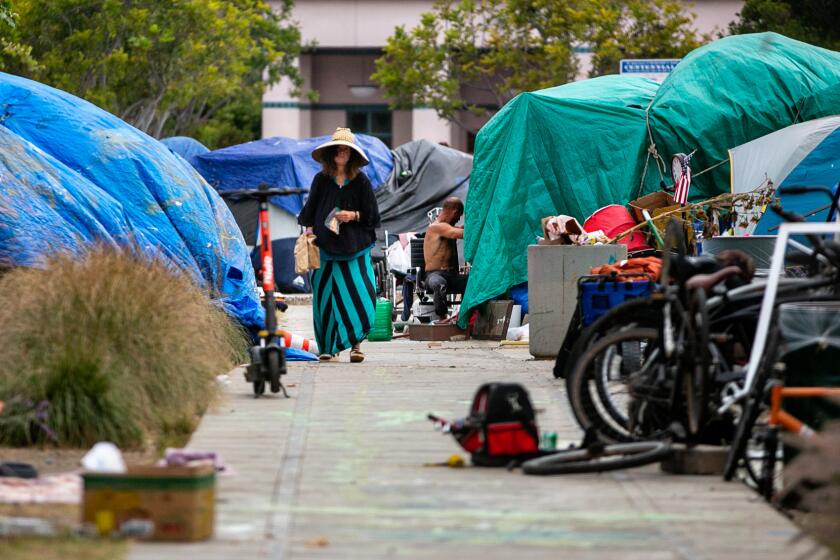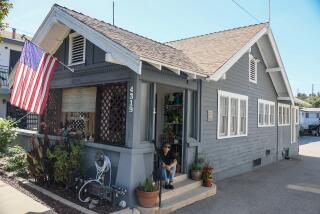Column: $60,000 ‘casitas’ and giant awnings: Caruso, Bass pitch cheaper homeless units

Rick Caruso stood in the doorway of a $60,000 house near the Van Nuys Airport, ready to offer tours.
Did I just say a $60,000 house?
In Los Angeles?
Yes, I did.
It was impressive, too, as much as a pre-fab, boxy structure can be. And it took just a few days to raise in the backyard of a home belonging to a family that’s renting the place to a Pierce College student for $800 a month. The accessory dwelling unit, as it’s called, has a studio-type layout and feels like a hotel suite. It has a kitchen, bathroom, air conditioning, washer and dryer.
“I love it,” said Livia Pereira, the student, who plays soccer at Pierce. “It has everything I need.”
In the race for mayor of the city, I see a positive, hopeful trend. Caruso, the developer and businessman, and Rep. Karen Bass (D-Los Angeles), have keyed on something that’s been painfully evident for years:
It costs way too much and takes far too long to build housing in a city with a sprawling catastrophe on its hands — 40,000 homeless people. In neighborhoods throughout Los Angeles, both the housed and unhoused are affected.
“So you get 12 of these for one of what they’re doing,” Caruso said.
To be precise, the latest data on average cost of supportive housing units is just under $600,000, but the prices leap beyond $800,000 in some cases.
“What I love about this — it can be temporary, it can be interim and it can be permanent,” Caruso said, seated at a breakfast bar in the home. “We can create a family unit on this because we have more and more families hitting the streets … and it’s a big solution for affordability.”
Caruso wants thousands of tiny homes and ‘sleeping pods.’ Bass proposes some interim units, while pushing to expand vouchers, motel rooms, apartments and incentives to landlords.
Bass is on the same wavelength. A couple of weeks ago, I visited a senior supportive housing unit in Hollywood with her, and when she heard the cost — $525,000 — she uttered the name of a famous carpenter:
We later toured an impressive cargo container village near Chinatown, where more than 232 units took about four months to build and cost roughly $220,000 apiece. That’s more like it, Bass said, promising to align all sectors of the approval, funding and construction process and get them to act like we’re in an emergency, because we are.
Bass now has her eye on a local company called Urban Awnings, which is designing two-story micro-housing communities of 20 units or so that would sit under a giant awning — the sketches remind me a bit of the SoFi Stadium roof. The awning would heat and cool the housing campus and possibly produce solar energy.
The estimated price is $145,000 per unit (not counting land costs, which could vary widely depending on public versus private spaces). Bass is scheduled to pitch the model Monday, along with City Councilmember Curren Price and Southwest Carpenters.
“This is a great avenue for jobs,” said Louis Ontiveros, an executive with the union.
He told me the union is using apprentices at $18 an hour plus benefits to build prototype units in Whittier. Ontiveros said wages for carpenters go up to $46 an hour plus benefits, and if lower-cost units become more common, not just for homeless housing but for workforce housing, “our carpenters can build them and live in them and flourish in the city.”
As for the $60,000 home in Van Nuys, the model Caruso showcased is a departure from his earlier claim that if elected mayor, he would house 15,000 people in tiny homes and 15,000 more in shelter settings (details still unclear).
He told me that after more research, he’d concluded that the 8-foot-by-8-foot tiny homes are too small and that many of the residents had issues with them, so he began investigating alternatives with more space and privacy. That took him to Nevada, where he checked out a company called Boxabl.
There, he met Leo Meza, an L.A. builder who has bought three Boxabl “casitas,” as they’re called, including one he gave to his sister, Gloria Trejo. She’s a school district office worker, and she had been renting a room of her Van Nuys house to the Pierce College student. Now the student has her own space, the backyard casita.
Meza said he hasn’t tallied the cost of the hookups to water, sewer and electrical lines, but said such work can run about $10,000 to $20,000, in his experience. The unit in his sister’s yard is not yet permitted, which could of course lead to a red tape nightmare.
Caruso says part of his mission is to shred such barriers. And modular homes can be stackable, he said, so it’s possible to create two-story villages on property owned by the city, county and other public agencies, saving land acquisition costs. He said all the necessary rehab and mental health services could be stationed on site.

Stephanie Klasky-Gamer, president of L.A. Family Housing, likes the concept. But she noted that various requirements — prevailing wages, environmental regulations, etc. — often drive up costs and drag out construction time.
So does the soul-sucking nightmare of regulatory torture.
“If you have 10 sources of funding, each one has an attorney, and each one drives us utterly crazy with requirements,” developer Tom Safran told me earlier this year.
So at the checkout stand, does the $60,000 casita get rung up as $100,000, $120,000 or more?
Yes, but it shouldn’t have to be that way, and Caruso and Bass are not the only ones searching for ways to build faster and cheaper. Sarah Dusseault, of the county Blue Ribbon Commission on Homelessness, has been doing her own research into modular homes.
“I’ve seen them as low as $40,000 and all the way up to $90,000,” said Dusseault, who helped oversee the development of the cargo container village I visited with Bass.
Dusseault is strategizing with various groups to waive some of the typical fees and hoop-jumping that kill momentum.
“Time is money,” she said. “If we as voters are fed up about the cost, we have to figure out how to eliminate that length of time, so it doesn’t take four or five or six years as it has with some of these projects.”
Rick Caruso and Karen Bass are running for Los Angeles mayor. Here is your guide to the race.
As I see it, a tiny home is better than a tent, and modular housing is better than a tiny home. But there are no two homeless people with identical needs, and no single housing approach alone can work for everyone. We need lots of everything, and Bass — who would put fewer than 1,000 people in Urban Awning homes — has a longer and more detailed list of housing options than Caruso.
But the type of dwelling doesn’t matter much without one outreach army to bring people inside and another battalion to support them with addiction and mental health rehab and other services.
The tiny home report card, as I wrote recently, is mixed because of severe shortages in services and permanent housing. There’s been a lack of security in the tiny homes, and reports of crime in the surrounding neighborhoods, with many tiny home occupants walking away rather than wait for permanent homes to become available.
“We … believe the pandemic and staffing challenges are at the heart of the return to unsheltered homelessness,” said Emily Andrade, director of interim housing for the Los Angeles Homeless Services Authority. She said housing navigators are now being employed to try to boost success rates.
There is, in other words, a long, long way to go. Caruso’s vow to house 30,000 people in his first year seems more like a hallucination than a vision, and even Bass’ number — which her team has upped from 15,000 to 17,000 — is a reach.
Each would need to come up with a lot of money as well as council support and county cooperation, and history tells us that good intentions often get pulverized in the meat grinder of political division and bureaucratic sloth.
But the dueling housing pitches from the candidates are a good thing.
Adding less expensive housing to the mix, and chopping down construction time, are a step in the right direction.
More to Read
Sign up for Essential California
The most important California stories and recommendations in your inbox every morning.
You may occasionally receive promotional content from the Los Angeles Times.












